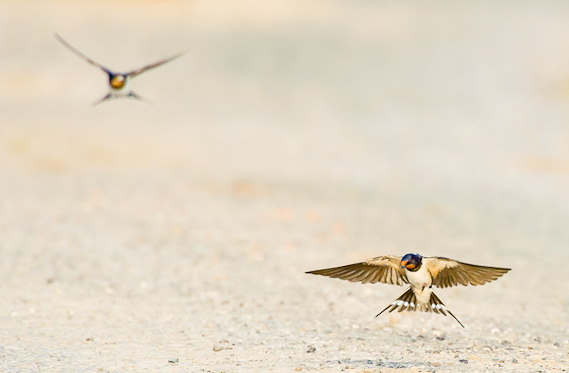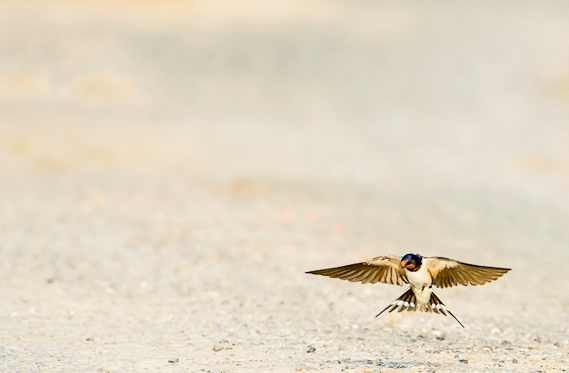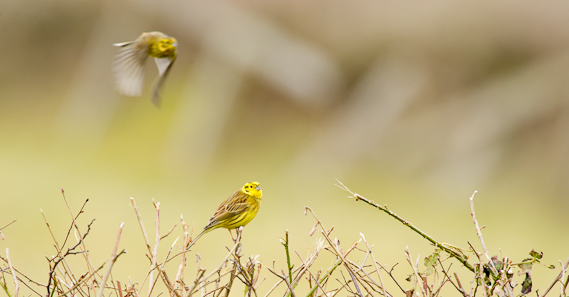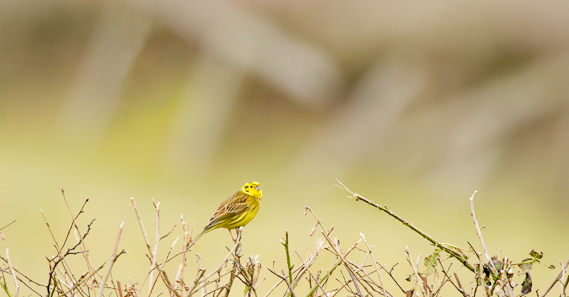A couple of interesting images here (yellowhammers and swallows) that would be good to get some responses from. They both have birds in the background that are clearly out of focus but for me they work better for it.
The out of focus bird is always by chance, never a conscious inclusion, it just happens.
Two Questions
So, there are two questions to be posed:
Do the images work better with the out of focus birds in the frame or not?
and …
Is it ethical to remove these blurred birds from the image?
Your views
Two simple questions that would be good to get your opinions on. So let me know, am interested to hear your views!
Both birds were removed very quickly and reasonably effectively with just the Content-Aware Fill tool in Photoshop CS5.





Hi Tim
Leaving the out of focus bird in gives greater depth to both images and adds to the context, without – the images look a bit sterile, another bird on a stick !
is it ethical to remove them ? – thats difficult to say , it depends on the story your trying to put across in the image.
Oh ! By the way Whats Ethical mean ?????
The depth bit is really interesting and you’re absolutely right, the image with the out of focus birds carry much stronger feeling of real space and thus gives emphasis to the sharp bird. Looking at them side by side and glancing quickly at them it’s amazing to feel the depth change between the two – I’d never thought of it like this.
I suppose we are all gong to have differing ethical frameworks and it can mean one thing to one person and another to another. Not an easy word.
The image works better with the bird removed in my opinion.
Ethically in this situation I think it’s fine.
Though if it was submitted for a competition it may cause issues.
Update
First image with bird
Second image without bird
You’re right, competition wise you could get into very deep water and it’s something to steer away from. I like those with the out of focus birds as I feel it gives a little more context to the shot. Although tomorrow I’ll probably change my mind!!
Hi Tim
I feel the swallow shot works best with the out of focus bird removed and the yellow hammer one with the out of focus bird retained. The swallow image could actually be cropped to remove the second bird therefore there wouldn’t be an ethical issue. The swallow is also doing something so that is where your eye should be drawn whereas the second yellowhammer contributes to the scene.
Is it ethical to remove features? I don’t have a problem with that. However it does raise the question, “Should the photographer reflect on how good the image is to start with if they are considering taking such measures?”
You’re right about the crop Joyce – cropping really is a form of post editing and if we are to be absolutely true to the image then we should never crop – a bit like Henri Cartier Bresson and his fidelity to the original image as seen. I don’t think I could cope with ‘no cropping’ however. As regards the ethical issue of removing unwanted and distracting stuff I think there is probably a line somewhere to be drawn, but where that line isa would be is a really tricky question.
Thanks for the contribution and I’ll catch up with you sometime, hope it’s all going well and do send me a link to your new sites when you’re ready.
Interesting views here… I really like both the images with the out of focus birds. There is more narrative to them somehow… it’s almost as if the out of focus bird was the in-focus bird moments earlier.
As far as the ethics go, I think it entirely depends on what the final image is being used for. Anything for use in a scientific context then obviously any manipulation beyond the very simple is a definite ‘no, no’. If I was putting together a design though and needed to get rid of certain background elements to create copy space then I’d have no qualms about doing so!
Both imagess are equally good although I like the top one with the out of focus bird but not the second one – it all depends on what one likes to see. The shape of the out of focus bird in the second image to me is off-putting whilst I think the shape of the out of focus bird in the top image is pleasing on the eye – all subjective really.
Cropping is perfectly acceptable after the image has been taken make the image more in line with what the photographer was trying to convey – sometimes the taken image has too much information and cropping simplies and make an image more aesthetically pleasing – nothing wrong with it as long as the photographer is not intending to portray a strict factual representation. if it is intended to be entirely accurate then of course no manipulation of any sort should occur but that is not the intention of most photographers especially amateurs just starting out on their journey.
I think we’re beginning to get some sense of where the line may be with all this. If it’s scientific, as Hugh says, then we’ve got to be careful and hold to the pure integrity of the image, but if we are using it in another context, design, art then maybe we shouldn’t get to hung up about it.
Marilyn has expressed the same sentiments, ‘strict factual representation’, ‘ entirely accurate’ if that’s our aim then we can’t manipulate – but as she goes on to say, that’s not the intention of most photographers.
Honesty in what you do and not hiding behind a false assumption that the image is ‘pure’ is also crucial. Don’t be afraid to state if it’s been manipulated and just be careful of entering any competitions.
Both the images above, and the Avocet and Goldeneye in the the following post, would NOT be acceptable for most competitions –
Here’s the framework established by the judging panel for the British Wildlife Photography Awards BWPA
Processing images and manipulation: Digital adjustments permitted:
Within the framework of digital image editing the following is permitted. Minor cleaning work including removal of sensor spots and dust, moderate adjustments of: contrast, tonal values, levels, highlight and shadow, colour, curves, saturation, sharpening, white balance and noise may be undertaken. Removal of chromatic aberration, lens distortion and vignetting are acceptable. Cropping is allowed, but please bear in mind that cropping reduces the file size and therefore high levels of cropping could result in the deterioration of image quality, for reproduction needs. Conversion to black and white is fine. Stitched images (combined using digital techniques) where a panorama is created from several images taken from the same location and at the same time are acceptable. This kind of work is comparable to what would be deemed as acceptable darkroom processing techniques. The aim is to achieve a true representation of a natural form, behaviour or phenomenon. Images where the physical characteristics of the scene at the time of taking have been altered are not eligible. The image should be a faithful representation of the original scene.
Digital adjustments not permitted:
Physical changes to the scene e.g. adding or removing objects, trees, animals, plants, people, items of civilization or stripping in sky from another image etc. Digital collages, sandwich shots and composites.
Photography is an art like any other and is as much about what isn’t in the frame as what is in the frame. I agree that honesty is the key – the context in which the image is presented is everything.
The big problem that many photographers, public broadcasters, competition organisers etc., choose to ignore is that in wildlife photography the viewer is coming to it with the (understandable) assumption that the scene or photo is for real and ‘in the wild’ in every sense. The use of the term ‘wildlife’ to describe a television documentary or a photography competition says it all. Without that assumption in the first place why would a viewer bother to be interested?
The British Wildlife Photography Awards rules are to be applauded for going further than wildlife television broadcasters do in including digital manipulation and zoo shots as a no no but the door remains wide open for someone to lead the way and go the whole hog and outlaw all forms of undisclosed manipulation, of both the subject and the digital image.